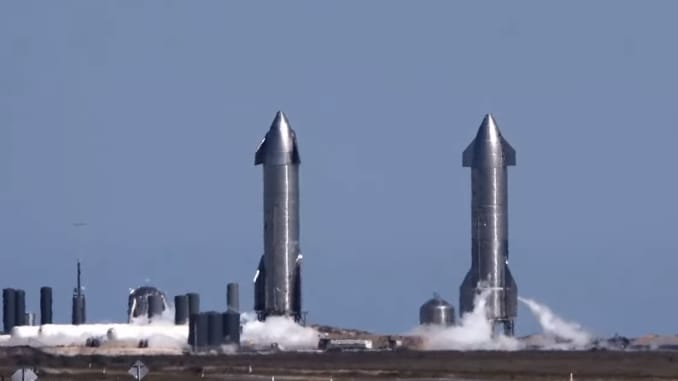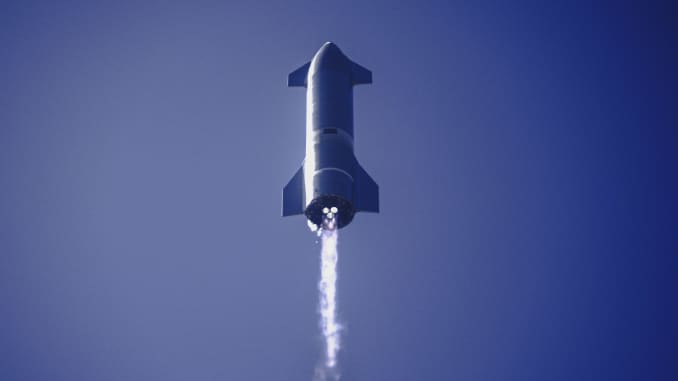What’s Behind SpaceX’s $74 Billion Valuation: Elon Musk’s Two ‘Manhattan Projects’
Elon Musk’s SpaceX is now worth $74 billion after it raised more capital last week, with strong demand from investors who believe the company’s two ambitious projects will drive that valuation even higher. Starship and Starlink are “two Manhattan Projects running in parallel,” Quilty Analytics founder Chris Quilty told CNBC The former is a next-generation rocket the company is developing, while the latter is the global satellite internet network that SpaceX has begun to roll out. “Is Elon about to do to telecom what he’s done to cars and batteries?” Jonas asked about Starlink’s satellite internet service.
Elon Musk’s SpaceX is now worth $74 billion after it raised more capital last week – and the strong demand for shares means many investors believe the company’s two ambitious projects will drive that valuation even higher.
The company’s valuation jumped 60% from its previous capital raise, which was just six months ago. And SpaceX’s latest round of fundraising saw the company receive $6 billion in offers from investors over the course of just three days, a source familiar told CNBC, with the company accepting $850 million from those offers.
The investor demand stems from its Starship and Starlink projects, Quilty Analytics founder Chris Quilty explained, which he described as “two Manhattan Projects running in parallel.” Quilty runs a boutique research and investment firm focused on the satellite communications sector, which he established after leading Raymond James’ coverage of the space industry for 20 years.
Starship is the next-generation rocket that Musk’s company is developing, designed to be more powerful than even the Saturn V rockets that carried astronauts to the Moon. Starlink is a global satellite internet network made up of thousands of satellites, which SpaceX is beginning to use to bring high-speed internet to customers.
Top Wall Street and industry analysts spoke to CNBC this week to help explain the excitement around SpaceX’s Starship and Starlink programs.
“This valuation is based on a vision of what SpaceX is able to achieve in the future,” Carissa Christensen, CEO of Bryce Space and Technology, told CNBC. “Their valuation is very high, given the commercial launch market is measured in billions of dollars – not tens or hundreds of billions – so you also need to look to Starlink.”

While investors may be getting in at a seemingly lofty $74 billion valuation, Ark Invest analyst Sam Korus thinks that it’s possible that SpaceX itself could become a trillion dollar company.
“I honestly don’t know of any company in the industry moving at SpaceX’s rate of innovation,” Korus told CNBC.
How Starship changes the launch paradigm

SpaceX “shook up” the global marketplace with the low cost and unprecedent launch rate of its Falcon 9 rockets, Jefferies analyst Greg Konrad explained. Reusing the Falcon 9 rocket boosters, which SpaceX has landed 67 times, has been critical to SpaceX both keeping costs low and launching quickly.
Historically, rockets that launched satellites and other large spacecraft were expendable – with the boosters discarded in the ocean after each launch. Konrad emphasized that the lower cost of SpaceX’s rockets has created “new opportunities for what you can launch and in what markets,” with other companies now working on reusing rockets.
“New competitors, like Blue Origin, are creating this whole ecosystem of launch vehicle providers that are servicing the lower end of the market with cheaper solutions,” Konrad said.
But SpaceX wants to take an even bigger step with Starship. Musk aims for Starship to be fully reusable – not just the booster, which is the bottom portion of the rocket – by landing and relaunching in a way more similar to a commercial airliner.
Starship and its booster stands nearly 400 feet tall and would offer more capability than any rocket before it, to meet Musk’s goal of launching as much as 110 tons of cargo at once.
“Some of the opportunities we can’t necessarily envision today, because space then becomes just that much more affordable on the heavy lift side,” Konrad said.
SpaceX has yet to reach orbit with a Starship rocket, but it is rapidly building and testing prototypes at its facility in Boca Chica, Texas. The company has successfully launched multiple Starship prototypes, landing them safely after short flights to about 500 feet altitude.
Its two most recent high-altitude flights, despite passing multiple development milestones, exploded on impact during attempted landings. SpaceX has not disclosed how much its has spent on the Starship program to date, but Musk previously estimated that he expects it will cost the company about $5 billion to complete.
Despite the explosive endings of its recent flights, Morgan Stanley analyst Adam Jonas echoed the company’s thinking that each Starship test represents a thrilling step forward.
“Find a cooler thing than watching a rocket of that size launch and land either successfully or land unsuccessfully. It’s wild,” Jonas said. “It’s like the Apollo era ‘right stuff.’”
Starship also represents the departure from the norm of developing a rocket “in close harmony” with the satellites it intends to launch, Christensen said.
“Meaning you’re not going to develop a satellite for which there is no obvious launcher,” Christensen said. “Starship is really a significant step beyond what is easily predictable.”
While a Falcon 9 rocket is advertised with a $62 million price tag, SpaceX has said the operational cost is about $28 million per launch. But Musk claims Starship’s full reusability would drive the cost per launch as low as $2 million, lowering the cost to reach low Earth orbit “by another order of magnitude or even further,” Korus said – meaning a reduction of about 10 times.

SpaceX captured a majority share of the U.S. launch market in the last few years, Christensen explained, with Falcon 9 taking “a bigger piece of an existing pie.”
“I think the vision for Starship is that it seeks to help that pie grow, whether that is building spacecraft that are larger or differently designed,” Christensen said.
The other benefit to Starship’s immense size would be to expand SpaceX’s capability for rideshare missions, when rockets carry additional satellites with its primary payload. Starship would have enough extra space “such that the secondary payloads can pay for the launch,” Jonas said – effectively subsidizing launches of the company’s own Starlink satellites.
Beyond carrying cargo, SpaceX plans to use Starship to carry people into orbit, and even to the surface of the moon and Mars.
“There’s also potentially the market associated with human spaceflight, which has historically been almost entirely … driven by government budgets,” Christensen said. “There’s a commercial human tourism market in space and we’re just seeing the beginnings of that.”
While a flight to orbit on SpaceX’s Crew Dragon capsule costs upwards of $200 million for four passengers, Starship would “unlock incredible opportunities,” Korus believes.
“Because it’s reusable, you could imagine trips around the moon in the $100,000 range,” Korus said.
Why investors are excited about Starlink

Jonas posed an open question about SpaceX’s amibition with Starlink, in light of the way Musk’s Tesla has disrupted the automotive and battery sectors.
“Is Elon about to do to telecom what he’s done to cars and batteries?” Jonas asked.
Starlink expected to be even more costly to develop than Starship, with SpaceX leadership previously the satellite network and consumer services will cost $10 billion or more to build out.
SpaceX has launched more than 1,000 Starlink satellites to date, with the company planning to deploy 4,425 satellites in orbit by 2024 to provide service to customers all over the world.
The company in October began offering early Starlink service through a public beta to customers in the U.S., Canada, and the U.K. It also recently widened the scope of that public beta, allowing prospective users to preorder Starlink service for $99.
Despite the heavy investment needed to build Starlink, the company’s leadership estimates Starlink will cost about $10 billion or more to build but believes that the network could bring in as much as $30 billion a year — or more than 10 times the annual revenue of its existing rocket business. Satellite communications is one of the most significant revenue streams within the space industry.
“There’s already a market established … so Starlink is seeking to enter that market,” Christensen said. “But it’s still an unproven question whether Starlink is able to succeed, even though it is a big piece of SpaceX’s valuation.”

Musk is well aware of the risk that SpaceX is undertaking with Starlink, noting several times in the past year that every prior low Earth orbit broadband satellite network has gone bankrupt.
“SpaceX needs to pass through a deep chasm of negative cash flow over the next year or so to make Starlink financially viable,” Musk said in a tweet earlier this month.
Quilty estimates Starlink needs to sign up a million or more users per year “in order to achieve the types of economics of scale needed to drive down costs that it becomes economically feasible.”
“It’s all about volume,” Quilty said. “What Starlink has going for it in part is the fact that Elon is a money raising machine.”
But the consensus among analysts is that the opportunity is there for Starlink to bring in many times the revenue of SpaceX’s rocket business. Christensen noted that telecommunications globally is a multi-trillion dollar market, and a growing demand for mobile internet access. It’s also “more familiar to investors,” Christensen said, so “there’s a degree of attractiveness there and more clearly understandable.”
Ark Invest named satellite internet as one of its “big ideas” for investors in 2021, with Korus estimating that Starlink has a $10 billion a year addressable market in the U.S. alone, and $40 billion a year globally.
“That’s on a household basis and that increases even further if you’re talking about businesses and we’ve heard that governments are very hungry for Starlink’s capabilities,” Korus said.
The space market

Jefferies’ Konrad also highlighted that there are a limited number of pure play space companies for investors to trade on the public markets. That, he says, has “created higher investor appetite for companies that have a higher percentage of growth.”
“There’s an insatiable appetite to invest in space-related businesses and, relative to what space could be, it’s a relatively untapped market,” Konrad said.
The space economy has been steadily growing and is estimated to be worth more than $423 billion currently, but several Wall Street firms expect it will become more than $1 trillion market by the end of the decade.
Jonas also emphasized the limited number of investment options as a catalyst for SpaceX. The company has a dominant position in the industry, and Jonas says Starship and Starlink mean the company “can touch a degree of markets that could be the largest TAM [Total Addressable Market] in the world, or amongst the largest TAMs in the world.”
Overall, Christensen believes Musk has brought a “Silicon Valley mindset” to an industry that was for decades dominated by defense-focused government contractors.
“Taking on multiple extraordinary ambitious projects at once is very well aligned with a company identity of transforming not just an industry, but arguably transforming the world,” Christensen said.
– CNBC



